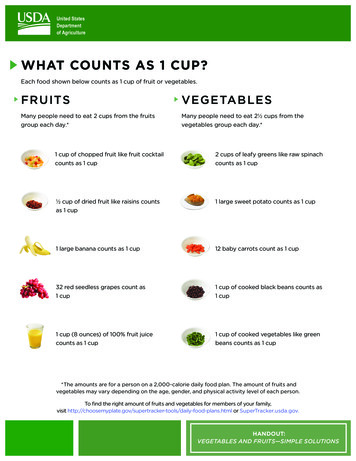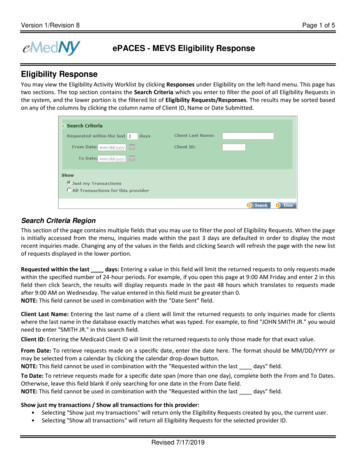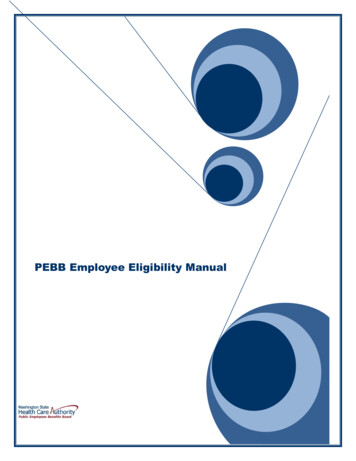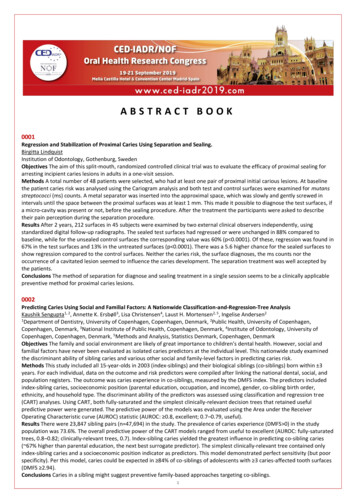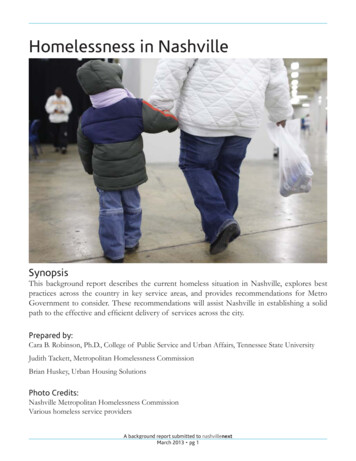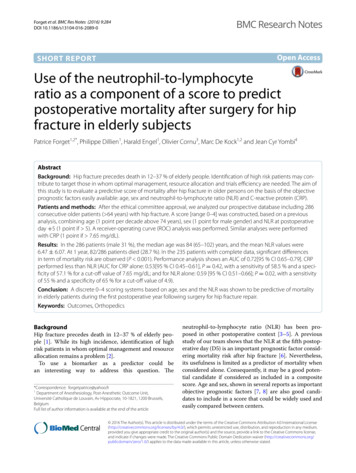
Transcription
Policy 613Income Eligibility: What Counts as Income?September 17, 2020POLICYWIC staff will appropriately include or exclude sources of income when determiningwhether Oregon WIC applicants or participants meet the federally defined income eligibilitystandard.PURPOSETo comply with the federal WIC income eligibility guidance.RELEVANT REGULATIONS7CFR §246.7 ¶(d)(2)(ii)—Definition of income7CFR §246.7 ¶(d)(2)(iv)—Income exclusionsFNS Instruction 803-3, Rev. 1 – Certification: Income EligibilityUSDA MEMO 803-L—Lump Sum Payments as Income (7/13/92)ASM 99-54—Strengthening Integrity in the WIC Certification ProcessWR Policy Memo 803-AV (ASM 02-45) Income Eligibility Determinations forHouseholds Affected by Privatization of On-Base Military HousingWR Policy Memo 803-AZ (ASM 04-46) Medicare Prescription Drug AssistanceASM 2010-02 Exclusion of Combat Pay from WIC Income EligibilityDeterminationASM 2010-5 Payments to Certain Filipino World War II Veterans – Exclusion from Incomeand ResourcesOREGON WIC PPM REFERENCES 610—Required Proof: Identity, Residence, Income 611—Income Eligibility: Determining Income Eligibility 612— Income Eligibility: Adjunct or Automatic Income Eligibility 614— Income Eligibility: Current Income Guidelines 615— Income Eligibility: Changes in IncomeAPPENDICESPage 613.8Page 613.9Appendix AWhat is Included as Income?Appendix BWhat is Not Included as Income?613.1
DEFINITIONSAttendance costs: For individuals receiving student loans, attendance cost includesregular tuition and fees for students carrying at least a half-time workload as determined bythe institution, and an allowance for books, supplies, and transportation required by thecourse of study.Income: Gross income, including overtime, before deductions for income taxes,employees’ social security taxes, insurance premiums, bonds, etc. The determination of theamount of a household’s gross income shall not be considered reduced for any reason(e.g.; financial hardships, medical bills, child support). Farmers and self- employed use netincome. Net income is determined by subtracting the operating expenses from the grossincome.BACKGROUNDUSDA provides guidance on what constitutes income and what financial support ahousehold may receive that is not included in their gross income. This policy clarifies whatWIC staff should include and what should be excluded from household income calculations.PROCEDUREDetermining income eligibility1.0WIC staff must assess all sources of income for a household to determine which willbe included or excluded from household income calculations. See 611—IncomeEligibility: Determining Income Eligibility for more information on the process fordetermining income eligibility for all members of a household.Income sources2.0Identify those sources of household income which would constitute gross income(before taxes) for the time frame reviewed. Refer to 611—Income Eligibility:Determining Income Eligibility for determining appropriate time frames for differentsituations.3.0Local program staff shall use net income to determine income eligibility only forfarmers and self-employed persons. Net income is determined by subtracting theoperating expenses from the gross income.4.0The determination of the amount of a household’s gross income shall not beconsidered reduced for any reason (e.g.; financial hardships, medical bills, childsupport).5.0Use the information in the chart below to identity what is included or excluded fromhousehold income calculations.613.2
This is a summary. See Appendix A and B for a complete list.Consider as incomeDo NOT consider as incomeMoney paid for services (gross wages,salaries, tips – before tax)Certain military allowances – see¶13.0Social security benefits, including SSIpayments for disabled individualsFood stamps, other payments fromNational School Lunch Act programsDividends or interest on savings, bonds,incomes from trustFederal job training programpaymentsPublic assistance, welfare paymentsFederal volunteer programsUnemployment compensationFederal child care programsPension or retirement income (civilian ormilitary)Federal or state housing &energy assistance programsAlimony or child supportFederal compensation to NativeAmericansRegular contributions from people not livingin the householdFederal compensation for otherclaims, re- location, disaster, orinjuryNet rental income and royalty incomeFederal student loans beyond attendancecostsNet income from farm or self-employmentOther cash incomeFederal old age assistanceFederal student loans coveringattendance costs– See ¶11.0One-time, lump sum payments,such as an insurance settlement orproperty sale – See ¶14.0Salary6.0Salary is gross pay before any deductions, including deductions for taxes, socialsecurity, or insurance. It includes payment for work, made directly to the worker withno taxes withheld, such as childcare done in the home.613.3
Social Security7.0Social Security payments made to any member of an applicant’s household countsas income. Income also includes SSI for developmentally disabled or disabledindividuals paid to an applicant or another member of the applicant’s household.Interest8.0The dividends or interest on savings or bonds, incomes from estates or trusts areconsidered income. Any amount of capital that is regularly withdrawn and used tocover household living expenses is also counted as income.Retirement income9.0Pension or retirement payments (such as retirement income received bygrandparents or other household members, if part of the household supporting theWIC recipient), are considered income. This includes:Private pensions or annuitiesGovernment civilian employee pensionsMilitary employee’s pensions, including veteran’s paymentAlimony, child support10.0USDA regulations require that child support or alimony be considered as income tohouseholds receiving it, and not deducted from the income of the household payingit.EXAMPLE: Jim Pierce pays 250 a month in child support to Sherry Miller for theirdaughter Amy. If Sherry Miller applies for WIC, her income includes the 250 childsupport payment. If Jim Pierce applies for WIC for a child other than Amy, hisincome also includes the 250 he pays in child support. It is not deducted from histotal income. Jim Pierce cannot count Amy as a member of his household unlessshe lives with him 50 percent or more of the time.Child support may include any regular contributions from people not living inthe household but that is made regularly enough that the applicant dependson it.Student loans11.0The part of student loans or grants funded under Title IV of the Higher Education Actof 1965 is not considered income when calculating WIC income eligibility.Attendance costs paid for by the student loan are not considered income.Attendance costs are defined as regular tuition and fees for students carryingat least a half-time workload as determined by the institution, plus anallowance for books, supplies, and transportation required by the course ofstudy. Attendance costs do not include paying room (housing), board (food),or dependent care.Title IV student loan or grant amounts beyond attendance costs should beconsidered as income when figuring WIC program eligibility.613.4
Title IV financial assistance includes Pell Grants, Supplemental EducationalOpportunity Grant (SEOG), College Work-Study, Perkins Loans, StaffordLoans, and PLUS Loans/Supplemental Loans for Students.EXAMPLE: Julie Rose is getting a 5,000 PLUS Loan for attending collegefull time. Her tuition is 3,000, books 500, and transportation to and fromschool 500, for a total of 4,000. The portion of the loan counted asincome in determining her eligibility for WIC is 1,000 ( 5,000 - 4,000attendance costs 1,000 income).Student aidAny other type of student financial assistance provided directly to theindividual is considered income.Farms and self-employment12.0Net income is gross income minus business-related expenses, such as thosededucted when filling out a 1040 tax form. The applicant’s most recent completed taxreturn can indicate net income, but because conditions in farming and selfemployment may change rapidly, you should update that information with theapplicant’s best estimate if they feel this year’s income will be significantly different.The intent is to exclude business and farm expenses from income counted for WICeligibility.EXAMPLE: Sue Meers has started her own beauty shop, which generates 1,500 income a month. Sue estimates that the business-related expensesshe will report on her 1040 will be about 500, for rent, supplies, and utilities.Sue’s net monthly income, for determining WIC eligibility, is 1,000 ( 1,500gross income - 500 business-related expense).Payments made by the military13.0Follow the guidance below for payments made by the military:Payments made by the military for housingAny payment received directly by an applicant or participant employed by themilitary to cover on- or off-base housing is not counted as income whendetermining WIC eligibility in Oregon. Federal regulations give states theoption to not include this kind of allowance as income, so some states count itand some do not. Oregon does not. Payments made directly to a servicemember and appearing on the employee’s Leave and Earnings Statement(LES) as Basic Allowance for Housing (BAH) or Basic Allowance for Quarters(BAQ) is not counted as income when determining WIC eligibility in Oregon.EXAMPLE: The army pays Margaret Hoolihan 1,950 a month. This checkincludes 450 per month for housing because she lives off-base. This 450appears in her paycheck each month and is listed on the LES as BAH. Theincome used in determining Ms. Hoolihan’s WIC eligibility is 1,500 ( 1,950less 450 housing allowance).613.5
Payments made by the military for combat payAny combat pay received directly by an applicant or participant employed bythe military while serving in an area that has been designated as a combatzone is not counted as income when determining WIC eligibility.13.2.1. This only applies to combat pay that is received during the time theservice member is deployed to a combat zone.One-time payments made by the militaryFor service members receiving one-time bonus or clothing allowancesconsider income averaging for the year. (see chart regarding what counts asmilitary pay or allowance)What Military Pay or AllowanceDoes CountWhat Military Pay orAllowance Does Not Count Basic Allowance for Housing(BAH or BAQ) Family Separation Housing(FSH) Overseas Housing Allowance(OHA) Overseas Continent UnitedStates Cost of Living Allowance(OCONUS COLA) Combat pay as a result of theservice member being deployed to adeclared combat zone. (May beImminent Danger Pay or HazardousDuty Pay (HZD Pay)) Base pay – the soldier’s regular rateof payBasic Allowance for Subsistence(BAS)Foreign Language Pay (FLP)Family Separation Allowance(FSA)Jump Pay, Dive Pay, Sea Pay, FlightPay, etc. (unless service member isdeployed to a combat zone)Clothing Maintenance Allowance(CMA) – can be averaged for theyear.Bonus Pay (Bonus) – can beaveraged for the year.Continental United States Cost ofLiving Allowance (CONUS COLA)Lump sum payments as income14.0Apply the following guidelines when determining how to treat lump sum payments forWIC income eligibility.Do not count as income lump sum payments that represent reimbursementsfor lost or damaged property or payments for medical bills resulting from anaccident or injury.Count as income lump sum payments that represent new money intended forincome such as gifts, inheritances, lottery winnings, workman’s compensationfor lost income, and severance pay. In most cases, the lump sum should be613.6
counted as a part of the household’s annual income or divided by twelve toestimate a monthly income.If the lump sum payment does not clearly represent either reimbursement ornew money, then ask the applicant to declare what portion of the payment is areimbursement and what portion is new income. The portion that is declaredas new money will be counted as income.15.0Refer to Appendix B for specific financial resources which are excluded from WIChousehold income calculations.If you need this in large print or analternate format, please call 971-673-0040.This institution is an equal opportunity provider.POLICY HISTORYDate9/17/2020* Major Revision, Minor revisionMinor revisionsThe date located at the top of the policy is the implementation date unless an “effective date” is notedon the policy. Policies will become compliance findings 6 months from the implementation date.Release notes can be found in the corresponding document on the Policy and Procedure Manual page.*Major Revisions: Significant content changes made to policy.Minor Revisions: Minor edits, grammatical updates, clarifications, and/or formatting changes have occurred.Date of Origin: Date policy was initially released613.7
APPENDIX AWhat Is Included as Income?Income includes the following:a. Payment received for services including wages, salary, commissions, or fees, andovertime where applicableb. Disability payments, including worker compensation paymentsc. Social security benefits, including SSI payments for disabled individualsd. Dividends or interest on savings, bonds, estates, or trusts; or net rental incomee. Temporary Assistance to Needy Families paymentsf. Unemployment compensationg. Government civilian employee or military or veteran’s paymentsh. Payouts from private pensions or annuitiesi.Alimony or child support paymentsj.Regular cash contributions from persons not living in the householdk. Net royaltiesl.Other cash income which includes but is not limited to, cash amounts received orwithdrawn from any source, including savings, investments, trust accounts, and otherresources which are readily available to the family.m. Lump sum payments that represent new income such as gifts, inheritance lotterywinnings, workman’s compensation for lost income and severance pay. (Refer to LumpSum Payments on ¶14.0 of this policy.)n. Cash amounts withdrawn from Indian Trust Fundso. Student loans and grants in excess of attendance costs. Attendance costs are regulartuition and fees for students carrying at least half-time workload as determined by theinstitution, and an allowance for books, supplies, and transportation required by thecourse of study.p. All private student grants or scholarshipsq. Military cash allowances for uniforms and foodr. Net income from farm and non-farm self-employment613.8
APPENDIX BWhat Is Not Included as Income?Income does not include the following:a. Federal student loans and grants used for tuition, student fees, the costs for rental orpurchase of any required equipment, materials or supplies, books, transportation andmiscellaneous personal expenses for a student attending the institution on at least a halftime basis. Following are examples of student loans and grants that are not counted asincome:1. Pell Grant2. Supplemental Educational Opportunity Grant (SEOG)3. State Student Incentive Grants4. National Direct Student Loans5. Stafford Loans6. Perkins Loans7. PLUS8. Supplemental Loans for Students9. College Work Study10. Byrd Honor Scholarshipsb. Payments or allowances received from the Low-Income Home Energy Assistance Act of1980c. Military Basic Allowance for Housing or Cost of Living Allowances for service membersliving outside of the contiguous states of the U.S.d. In-kind housing or other in-kind benefits and payments (e.g. free room in exchange forbabysitting, military on-base housing and medical services)e. The value of benefits received through the Farmers Market Nutrition Programf. The value of assistance to children or their families from the following programs:1.2.3.4.5.6.7.8.School Lunch ProgramSummer Food Service ProgramChild and Adult Care Food ProgramSpecial Milk ProgramSchool Breakfast ProgramSupplemental Nutrition Assistance Program (SNAP)Food Distribution Program on Indian Reservations (FDPIR)Food Bank Programs613.9
g. Any childcare payments from the following programs:1.2.3.4.TANF Child Care ProgramTitle IV-A Child Care ProgramJOBS Child Care ProgramAt-Risk Child Care Programs (Sec. 402 of Social Security Act, or Section 5081 ofPublic Law 101-508)5. Child Care Development Block Granth. Lump sum payments that represent reimbursements including those received frominsurance companies for loss or damage of property and payments of medical billsresulting from an accident or injury. Refer to pages 613.5 and 613.6, ¶14.0 of this policy.i.Earned Income Credit (EIC), a tax credit for families who work and have children.j.Payments received under the Job Training Partnership Act from the following programs:1.2.3.4.5.6.7.Adult and Youth Training ProgramsSummer Youth Employment and Training ProgramsDislocated Worker ProgramsPrograms for Native AmericansMigrant Seasonal Farm-workers ProgramVeterans Employment ProgramsJob Corpsk. Payments received under the Alaskan Native Claims Settlement Act.l.Income derived from certain sub-marginal land of the United States that is held in trust forcertain Indian tribes.m. Any payments to volunteers under Title I and Title II of the Domestic Volunteer ServiceAct of 1973 (VISTA, Retired Senior Volunteer Program, foster grandparents, SeniorCompanions Program, and others) or the Small Business Act.n. Payments to volunteers under Section 8 of the Small Business Act (SCORE and ACE).o. Payments under the Disaster Relief Act of 1974, as amended by the Disaster Relief andEmergency Assistance Amendments of 1989.p. Payments related to federal education assistance as follows: payments received underthe Carl D. Perkins Vocational Education Act and the Carl D. Perkins Vocational andApplied Technology Education Act Amendments of 1990; mandatory salary reductionamount for military service personnel to fund the G.I. Bill.q. Payments received due to the Agent Orange Compensation Exclusion Act.r. Payments received from Wartime Relocation of Civilians under the Civil Liberties Act of1988.613.10
s. Reimbursements from the Uniform Relocation Assistance and Real Property AcquisitionPolicies Act of 1970.t. Payments received under the Old Age Assistance Claims Settlement Act, except for percapita shares in the excess of 2,000.u. Payments received under the Judgment Award Authorization Act.v. Payments received under the Veteran’s Educational Assistance Act of 1984 (GI Bill)as amended.w. Payments received under the Cranston-Gonzales National Affordable Housing Act,unless the family’s income equals or exceeds 80% of the median income of thearea (see box below).x. Payments received under the Housing and Community Development Act of 1987,unless the family’s income increases at any time higher than 50% of the medianincome of the area:The “median income of the area” is determined by the Housing andUrban Development (HUD) agency. All recipients of payments underthe Cranston- Gonzales National Affordable Housing Act and theHousing and Community Development Act of 1987 have incomesbelow 80% and 50% of the area, respectively. Therefore, thesepayments would not be counted as income for WIC eligibilitypurposes. Federal law requires that this information be stated in theWIC Program Manual.y. Federal compensation to the following Native American groups: Warm SpringsTribe (Judgment Award Authorization Act funds up to 2,000 maximum perpayment); Yakima Indian Nation (Indian Claims Commission Payment); ApacheTribe of the Mescalero Reservation (Indian Claims Commission Payment); Navajoand Hopi Tribe (relocation assistance); Blackfeet, Grosventre, and AssiniboineTribes (Montana); Papago Tribe (a.k.a. Tohono O’odham Nation, Arizona);Chippewas: Mississippi, Michigan, Red Lake, Saginaw, Turtle Mountain; Sac andFox Indian (claims agreement); Passamaquoddy Tribe and Penobscot Nation(Maine Indian Claims Settlement Act, 1980); and Ottawa Indians, Grand RiverBand. Payments received under the Judgment Award Authorization Act, or incomefrom submarginal U.S. land held in trust for certain Indian tribes.z. Short-term, non-secured loans to which the applicant does not have constant orunlimited access.aa. Payments received by property owners under the National Flood InsuranceProgram (Pub. L. 109-64)bb. Any subsidy that a household receives through the Medicare/Medicaid prescriptiondrug discount card program.cc. Payments from the Filipino Veterans Equity Compensation Fund (Pub. L. 111-5)613.11
Determining income eligibility 1.0 WIC staff must assess all sources of income for a household to determine which will be included or excluded from household income calculations. See 611—Income Eligibility: Determining Income Eligibility for more information on the process for determining income eligibility for all members of a household.
